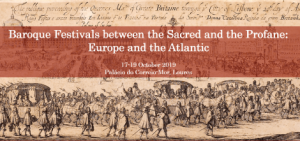 CFP: Baroque Festivals between the sacred and the profane (Loures, 17-19 Oct 19)
CFP: Baroque Festivals between the sacred and the profane (Loures, 17-19 Oct 19)
Palácio do Correio-mor, Loures, Portugal, October 17 – 19, 2019
Deadline-CFP: 15 juil. 2019
International Congress: Baroque Festivals between the Sacred and the Profane: Europe and the Atlantic
The Feast, a cultural manifestation encompassing all civilizations and creeds, reached its pinnacle of magnificence and extravagance during the Baroque period (17th-18th centuries). Courts, along with religious institutions, were the main promoters and spreaders of the grandiose scenographic events witnessed in this period of history. With models and fashions from European courts such as those of France, the Austro-Hungarian Empire and the Iberian Peninsula fanning out to the rest of the Old World, the festive eccentricity of Baroque also reached the overseas territories of South America under the rule of the Iberian monarchies.
Ephemeral art, the visible expression of the festive spectacle, takes over and transforms spaces in dialogue with the perdurable arts and the soundscape. The hegemony of painting, sculpture and architecture blurs in the dialogue established with the so-called decorative arts and with the performative arts. The feast brings together arts, artists, commissioners, participants and the public. A brief jubilatory event, it is the expression of the imagination, of the amalgam of arts and peoples, the apotheosis of the concept of the total work of art that Baroque gave rise to and that Leibniz, in his Monadology, understood as the art of finding « the beautiful constructions », that is, shaping imaginary worlds as possible as that in which we live.
The final composition of the festive display reflects the essence of Baroque: a play of multiple forms in dialogue with each other and in permanent unfolding: “la peinture sort de son cadre et se réalise dans la sculpture de marbre polychrome; et la sculpture se dépasse et se réalise dans l’architecture; et l’architecture à son tour trouve dans la façade un cadre, mais ce cadre décolle lui-même de l’intérieur, et se met en rapport avec les alentours de manière à réaliser l’architecture dans l’urbanisme » (Giles Deleuze, Le Pli, Minuit, 1988, pp. 167-168).
This conference seeks to open up an approach to this phenomenon with a focus on its artistic dimension. Given the diverse contributions that the arts bring to the Baroque Feast, such approach will be necessarily interdisciplinary and consider the phenomenon in the 17th and 18th centuries from renewed viewpoints based on the latest research.
Paper submissions are sought on, but may not be limited to the following topics:
– Staging, codes and rituals: the arts of the table, christenings, weddings, acclamations, royal entries, embassies;
– Theatres, staging’s, beatifications and canonisations, liturgical calendar processions, special devotions;
– Literature, books and prints: model dissemination and consolidation;
– Music and the sound element of the feast;
– The feast and the city: ephemeral scenography, its agents and impact on the urban scape.
We welcome proposals for 20-minute presentations in English, which should include:
– Title of the proposal;
– Applicant’s identification (name, institutional affiliation, country and email);
– Abstract (up to 300 words);
– Short Curriculum Vitae (up to 200 words).
Proposals must be sent in Word (.doc format) by email to: congress.baroque.loures2019@gmail.com
Deadline: 15 July 2019
A selection of papers from the conference will be published in Revista de História da Arte – Série W, an annual peer-reviewed digital journal.
Source : CFP sur ART HIST ; site officiel.

Leave a Reply
You must be logged in to post a comment.